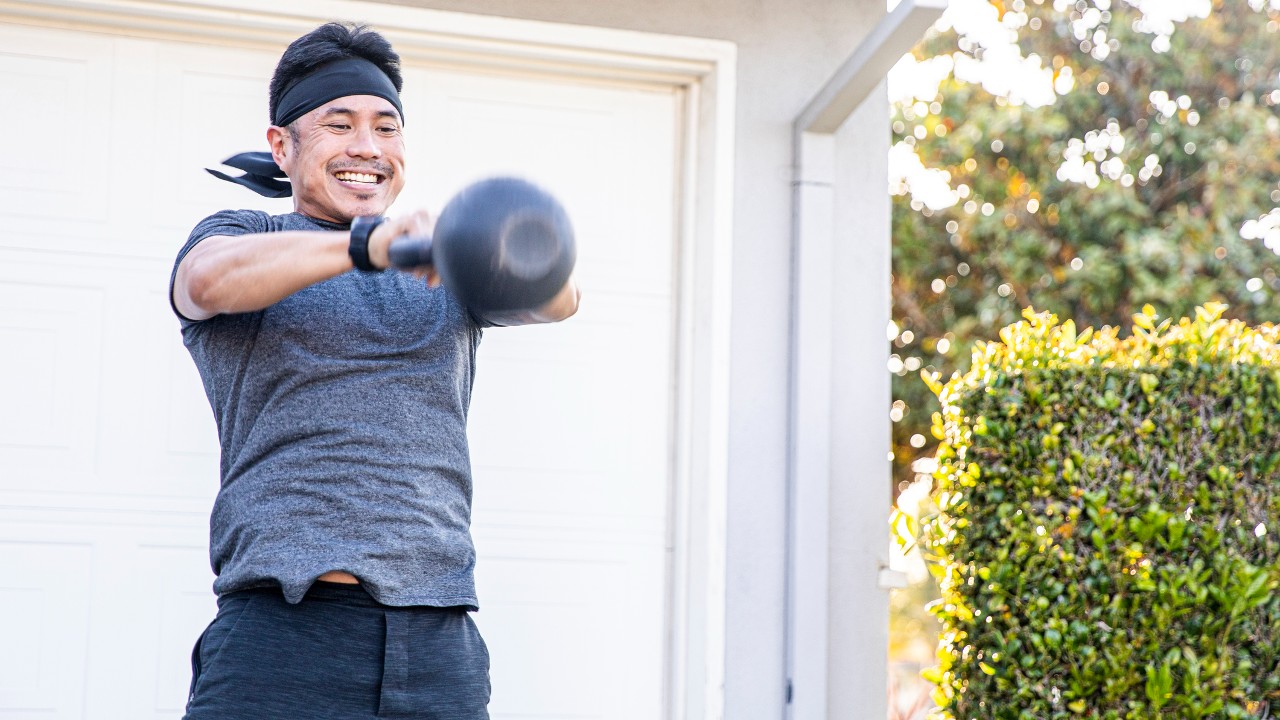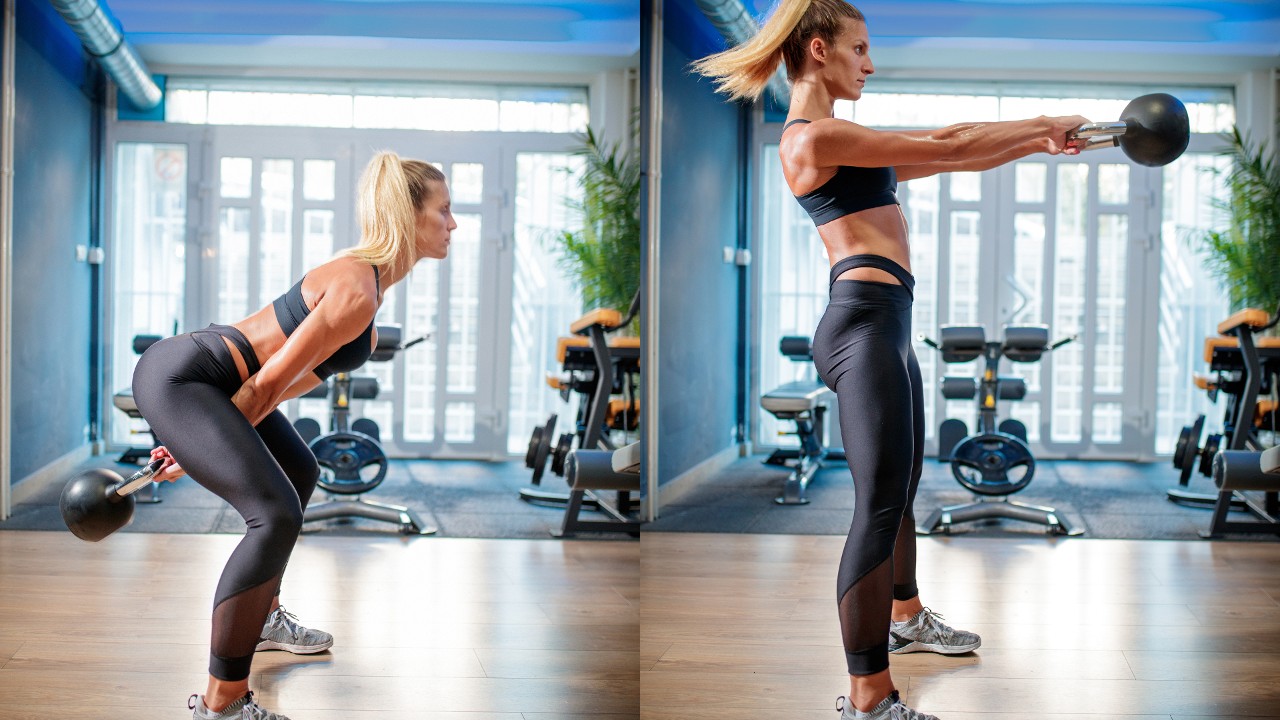How To Do The Kettlebell Swing
The kettlebell swing is ruthlessly effective yet often poorly executed. Use this expert form guide to swing the right way

With the rise of functional fitness, kettlebell training has soared in popularity. Racks of kettlebells are a fixture in commercial gyms and CrossFit boxes alike, and they feature in many bootcamp workouts. In all those settings, the most common kettlebell exercise you’ll see performed is the kettlebell swing.
It’s a worthy flagbearer too. In his book The 4-Hour Body, efficiency guru Tim Ferriss even heralded the Russian kettlebell swing as the ultimate one-move full-body exercise, arguing that all you need to eviscerate fat, strengthen your glutes and boost your deadlift strength is to perform 75 reps with a reasonably heavy kettlebell, two to three times a week.
If you want to learn how to do a kettlebell swing, you probably shouldn’t be copying the people you see doing it in the gym. Why? Because most people are doing it poorly at best, or downright dangerously at worst. That’s why we turned to Matt Wright, co-founder of the Earn Your Stripes fitness program and chief growth officer at The Fort Athletic Club in New Jersey, USA, for the definitive guide to this excellent exercise.
How To Do The Kettlebell Swing
The two-arm swing is the first kettlebell move you should master. It will teach you the basic movement pattern that forms the foundation of most kettlebell exercises, which you can then harness for more advanced variations. It’s also known as the Russian kettlebell swing. There is an American kettlebell swing, detailed in the progressions section below, which is a more advanced move—read into that what you will.
The set-up
Start with the kettlebell on the floor slightly in front of you and between your feet, which should be shoulder-width apart. Keeping your legs fairly straight, push your butt back and hinge at the hips to grasp the kettlebell with both hands, palms facing toward you. Then, says Wright, “pinch your shoulder blades together” to avoid rounding your shoulders.
The pull
Pull the kettlebell off the floor and swing it between your legs, keeping your weight in your midfoot and heels. Your arms should be resting against your body and your back should be flat. You should feel your hamstrings load up at this point, braced for action.
The swing
Now it’s time to turn on the power. Drive your hips forward to swing the kettlebell forward, allowing the weight to rise to shoulder level.
Get the Coach Newsletter
Sign up for workout ideas, training advice, reviews of the latest gear and more.
The return
Your arms should still be straight, with the kettlebell feeling weightless in this top position, says Wright, and your abs and glutes engaged. Allow the weight to return between your legs while ensuring you hinge at the hips, not the knees, to lead into the next rep.
Kettlebell Swing Form Tips

Shoulders: Keep your shoulders relaxed to avoid shrugging the kettlebell and ending up with your shoulders around your ears.
Glutes: As your arms come away from your body, squeeze your glutes to prevent overextending your lower back.
Head: Your head position should be neutral. The gap between your chin and your chest shouldn’t change throughout the exercise.
Elbows: Focus on keeping your elbows “soft” throughout the swing. Keep your arms relaxed to take the tension out of your arm muscles and harness the momentum from the weight of the kettlebell instead.
Knees: Your knees should remain fairly straight during the swing. The motion should be initiated from the hip hinge. This is a posterior chain movement (the muscles on the back of your body), not a quad-dominant one.
Common Kettlebell Swing Mistakes
Zero hip drive
“In every gym I’ve been to, the technique seems to vary, and you see some horrific demonstrations,” says Ashton Turner, co-founder of London’s Evolve 353 gym.
The most common mistakes he sees are an excessive knee bend, no hip drive, and too much arm involvement, turning what should be a dynamic, full-body thrust into an awkward front raise. “Ideally, your forearms should stay in contact with your body until you drive the kettlebell off your hips,” he says.
Relying on your upper body
“Don’t make the common mistake of using the upper body too much to get the weight moving,” says kettlebell master trainer Mike Mahler. “This limits what you can lift and how many reps you can do, and makes you far more likely to develop back issues.”
Instead, you want all the power to come from the posterior chain and in particular the hamstrings and glutes. “Put your entire body into each rep and keep the bell close to your body until the hip drive begins, then use your hip drive to swing the bell to shoulder level,” Mahler says.
Squatting rather than hinging
Wright says that “squatting rather than hinging, rounding at the shoulders and lifting with the arms” are by far the most common mistakes with this exercise, leading to greater stress on the lower back and shoulders, while stifling the “free-flowing” element that makes kettlebell training so effective.
His cues to address these errors are to concentrate on generating power from your hips, rather than the upper body, and gripping as if you’re “trying to rip the kettlebell handle apart”, exerting outward force on the handles helps to engage your upper-back muscles.
Benefits Of The Kettlebell Swing

The kettlebell swing might be commonly associated with fat-burning workouts and cardio-boosting metabolic conditioning circuits, but it is equally effective at developing explosive strength and power throughout your posterior chain.
In one study, which pitted kettlebell swing workouts against jump squats, those doing the former reported a 9.8% increase in maximum strength and a 19.8% improvement in vertical jump height, similar to the gains seen in the jump squat subjects.
In the paper, published in the Journal Of Strength And Conditioning Research, subjects performed 12 minutes of kettlebell swings, alternating 30 seconds on with 30 seconds off, twice a week.
Regular kettlebell swing training will also encourage you to keep your shoulders in a healthier position, offsetting the urge to slump your shoulders over your desk and forge mental grit and resilience that’ll cross over to any other workout you might do.
Kettlebell Swing Progressions
Once you’ve nailed the two-arm swing, start using these variations.
Once you’ve nailed the two-arm swing, start using these variations.
Kettlebell one-hand swing
Draw on the same technique outlined above but keep one arm out to your side as you swing the bell between your legs and up to shoulder level with one arm. “Keep your form similar to the two-hand swing,” says Turner. “It’s a very similar movement so concentrate on your hip drive. It requires more oblique work to prevent your body from rotating.”
Kettlebell swing swap
Now you’re just showing off. This drills hand-eye co-ordination as much as power. “Change hands at the highest point of the swing, where the kettlebell is weightless. You can take one hand off the kettlebell before the other hand is on it—but beginners should swap over while still holding on to the kettlebell,” says Turner.
American kettlebell swing
More power, more punch. This version follows the same technique as the Russian swing but requires you to let the weight rise until almost directly overhead. Be sure to stop before it goes completely overhead or you might find it pulling you off-balance. “It might look flashy but it’s a good test of your overall co-ordination, timing and control of the kettlebell,” says Turner.
Kettlebell Swing Workouts
10-Minute Fat-Torcher
Perform as many swings as you can in 60 seconds, using the form pointers above, and record the number of reps you complete. Rest for 60 seconds, then perform another minute of swings. Complete five rounds in total. Aim to beat your total rep score every time you attempt the challenge. “I do this as a quick and easy fat-burning exercise,” says Turner.
Swing ladder
Do the following moves in order without resting:
- 10 double-arm swings
- 10 left-arm swings
- 10 right-arm swings
- 10 swing swaps
Then do nine reps of the same four moves and continue that pattern until you do one rep of each move.
“This is a great test of your grip strength,” says Turner. “It’s a quick high-rep workout that involves doing 220 reps in just 15 minutes.”
About Our Experts
Matt Wright is co-founder of the Earn Your Stripes fitness program and chief growth officer at The Fort Athletic Club in New Jersey, USA. Formerly he was VP of personal training and programming at City Fitness in Philadelphia. He serves as an industry consultant, educator and presenter. Accredited via the IHRSA, Wright holds a Master’s degree in sport and exercise psychology with an emphasis on leadership and management from Temple University, and a Bachelor’s of Science in Kinesiology from Penn State University.
Mike Mahler is a renowned strength coach and kettlebell instructor based in Las Vegas. He’s the founder of the website Mike Mahler’s Aggressive Strength and specializes in hormone optimization via nutrition, training, supplements and lifestyle. Perhaps best known for teaching kettlebell workshops globally between 2002 and 2013, he is the author of a variety of best-selling kettlebell training e-books and DVDs, including Live Life Aggressively! What Self-Help Gurus Should Be Telling You, and host of the Live Life Aggressively podcast.
Ashton Turner is the co-founder of boutique fitness facility Evolve 353 in Parsons Green, London. Turner studied Sports Coaching at the University of Wales in Cardiff, is a UKSCA Level 1 strength and conditioning coach and has over 20 years of experience in one-to-one, small group and large group training.
Get help deciding on which kettlebell to buy with our expert guide to the best kettlebells.

Sam Rider is an experienced freelance journalist, specialising in health, fitness and wellness. For over a decade he's reported on Olympic Games, CrossFit Games and World Cups, and quizzed luminaries of elite sport, nutrition and strength and conditioning. Sam is also a REPS level 3 qualified personal trainer, online coach and founder of Your Daily Fix. Sam is also Coach’s designated reviewer of massage guns and fitness mirrors.
- Joe WarnerFormer editor of Men’s Fitness UK









